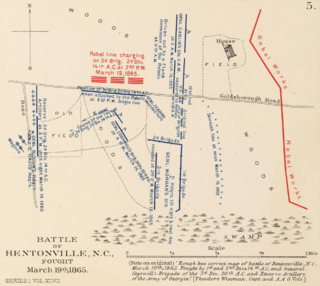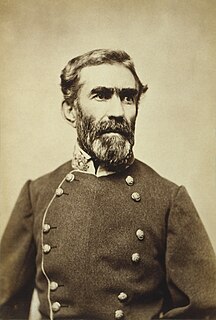
The Richmond–Petersburg Campaign was a series of battles around Petersburg, Virginia, fought from June 15, 1864, to April 2, 1865, during the American Civil War. Although it is more popularly known as the Siege of Petersburg, it was not a classic military siege, in which a city is usually surrounded and all supply lines are cut off, nor was it strictly limited to actions against Petersburg. The campaign consisted of nine months of trench warfare in which Union forces commanded by Lt. Gen. Ulysses S. Grant assaulted Petersburg unsuccessfully and then constructed trench lines that eventually extended over 30 miles (48 km) from the eastern outskirts of Richmond, Virginia, to around the eastern and southern outskirts of Petersburg. Petersburg was crucial to the supply of Confederate Gen. Robert E. Lee's army and the Confederate capital of Richmond. Numerous raids were conducted and battles fought in attempts to cut off the Richmond and Petersburg Railroad. Many of these battles caused the lengthening of the trench lines.

The Army of Tennessee was the principal Confederate army operating between the Appalachian Mountains and the Mississippi River during the American Civil War. It was formed in late 1862 and fought until the end of the war in 1865, participating in most of the significant battles in the Western Theater. It should not be confused with the Union Army of the Tennessee, named after the Tennessee River.

The Battle of Wilmington was fought February 11–22, 1865, during the American Civil War, mostly outside the city of Wilmington, North Carolina, between the opposing Union and Confederate Departments of North Carolina. The Union victory in January in the Second Battle of Fort Fisher meant that Wilmington, 30 miles upriver, could no longer be used by the Confederacy as a port. It fell to Union troops after they overcame Confederate defenses along the Cape Fear River south of the city. The Confederate General Braxton Bragg burned stores of tobacco and cotton, among other supplies and equipment, before leaving the city, to prevent the Union from seizing them.
The Army of the James was a Union Army that was composed of units from the Department of Virginia and North Carolina and served along the James River during the final operations of the American Civil War in Virginia.
The Army of the Ohio was the name of two Union armies in the American Civil War. The first army became the Army of the Cumberland and the second army was created in 1863.

Fort Fisher was a Confederate fort during the American Civil War. It protected the vital trading routes of the port at Wilmington, North Carolina, from 1861 until its capture by the Union in 1865. The fort was located on one of Cape Fear River's two outlets to the Atlantic Ocean on what was then known as Federal Point or Confederate Point and today is known as Pleasure Island. The strength of Fort Fisher led to its being called the Southern Gibraltar and the "Malakoff Tower of the South.". The battle of Fort Fisher was the most decisive battle of the Civil War fought in North Carolina.

The Tullahoma Campaign was a military operation conducted from June 24 to July 3, 1863, by the Union Army of the Cumberland under Maj. Gen. William Rosecrans, and regarded as one of the most brilliant maneuvers of the American Civil War. Its effect was to drive the Confederates out of Middle Tennessee and to threaten the strategic city of Chattanooga.
The Battle of Wyse Fork, also known as the Battle of Kinston, was a battle fought in the Carolinas Campaign of the American Civil War, resulting in a Union Army victory.

The Campaign of the Carolinas, also known as the Carolinas Campaign, was the final campaign conducted by the United States Army against the Confederate States Army in the Western Theater. On January 1st, Union Maj. Gen. William T. Sherman advanced north from Savannah, Georgia, through the Carolinas, with the intention of linking up with Union forces in Virginia. The defeat of Confederate Gen. Joseph E. Johnston's army at the Battle of Bentonville, and its unconditional surrender to Union forces on April 26, 1865, effectively ended the American Civil War.

The Western Theater of the American Civil War encompassed major military operations in the states of Alabama, Georgia, Florida, Mississippi, North Carolina, Kentucky, South Carolina and Tennessee, as well as Louisiana east of the Mississippi River. Operations on the coasts of these states, except for Mobile Bay, are considered part of the Lower Seaboard Theater. Most other operations east of the Mississippi are part of the Eastern Theater. Operations west of the Mississippi River took place in the Trans-Mississippi Theater.

The Eastern Theater of the American Civil War consists of the major military and naval operations in the states of Virginia, West Virginia, Maryland, and Pennsylvania, the District of Columbia, and the coastal fortifications and seaports of North Carolina.

The Camden Expedition was the final campaign conducted by the United States Army against the Confederate States Army in Arkansas, during the American Civil War. The offensive was designed to cooperate with Maj. Gen. Banks' movement against Shreveport.

The Battle of Fort De Russy, Louisiana, was the first engagement in the Red River Campaign of March–May 1864 in the American Civil War.

The Battle of Bentonville was fought in Johnston County, North Carolina, near the village of Bentonville, as part of the Western Theater of the American Civil War. It was the last battle between the armies of Union Maj. Gen. William T. Sherman and Confederate Gen. Joseph E. Johnston.
This is a list of battles and skirmishes of the American Civil War during the year 1865, the final year of the war. During the year, Union forces were able to capture the last major Confederate ports still open to shipping, along with the Confederate capital, and forced the surrender of the four major Confederate commands.

Ulysses S. Grant was the most acclaimed Union general during the American Civil War and was twice elected President. Grant began his military career as a cadet at the United States Military Academy at West Point in 1839. After graduation he went on to serve with distinction as a lieutenant in the Mexican–American War. Grant was a keen observer of the war and learned battle strategies serving under Generals Zachary Taylor and Winfield Scott. After the war Grant served at various posts especially in the Pacific Northwest; he was forced to retire from the service in 1854 due to accusations of drunkenness. He was unable to make a success of farming and on the onset of the Civil War in April 1861, Grant was working as a clerk in his father's leather goods store in Galena, Illinois. When the war began his military experience was needed, and Congressman Elihu B. Washburne became his patron in political affairs and promotions in Illinois and nationwide.
89th Indiana Infantry Regiment was an infantry regiment that served in the Union Army in the Western Theater of the American Civil War.























